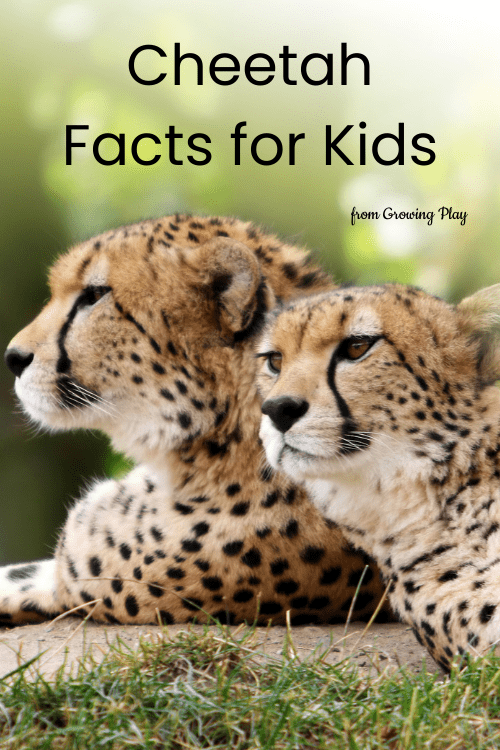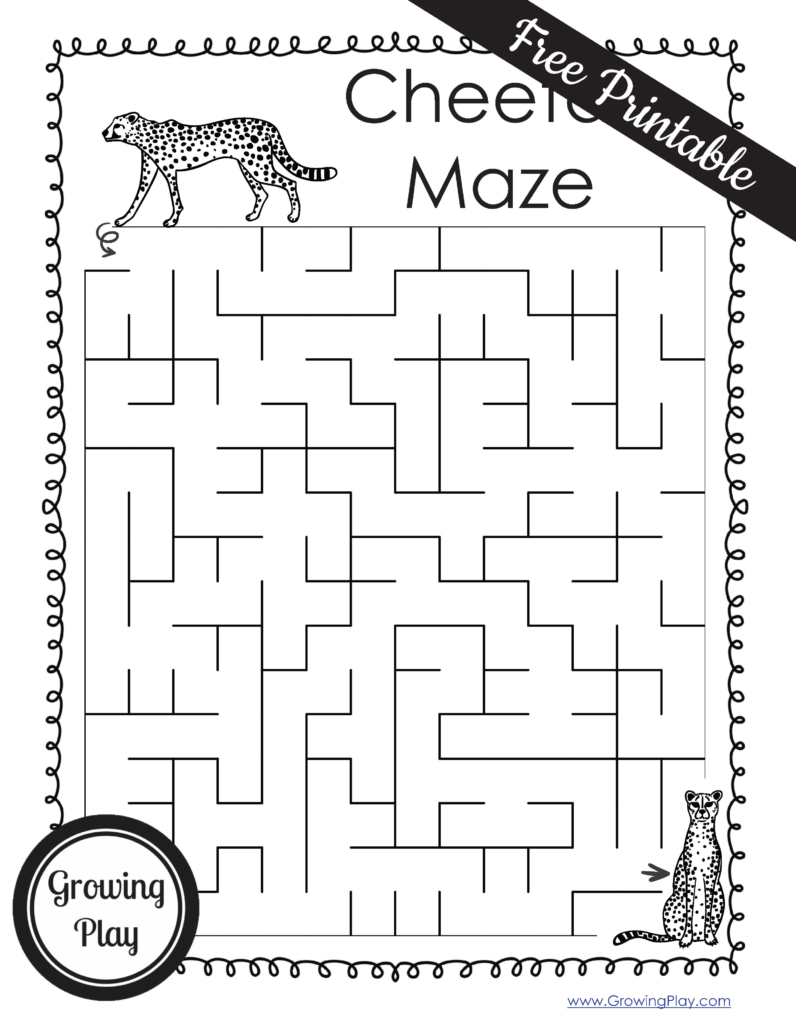Cheetah Facts for Kids

Do you know what the Acinonyx Jubatus is? How about I give you a hint – it’s a large cat with retractable claws and spots all over. They have small heads but large nostrils. Any guesses yet? What if I told you they were the fastest land animal, let alone the fastest animal! Do you know what I’m talking about now? That’s right! The cheetah. Cheetahs are big cats known for their speed and beautiful coat of fur and Acinonyx Jubatus is just the scientific name for them. Cheetahs have so much science within them from their long stride, flexible joints, carnivorous nature, and even their paws are special. Keep reading to learn how and while you’re at it, brush up in all these cheetah facts for kids.

BONUS: Download a FREE Cheetah Maze, Cheetah Hunt Puzzle, and Cheetah coloring page at the bottom of this blog post.
Cheetah Speed
1. Cheetahs are the fastest land animals in the world! They are even faster than birds and bugs. At full speed, they can run up to 70 miles per hour! That’s faster than most cars on the highway.
2. Cheetahs are built for lightning speed with long legs, a muscular tail, and special pads on their feet for traction. They also have a long tail and a long stride length that can be seen when they are running through open areas.
3. Cheetahs are very fast, but they can only sustain their top speed for a short distance; they typically tire after running for about 1/3 of a mile.
4. Cheetahs use their incredible speed to help them catch their prey; they can accelerate from 0 to 60 miles per hour in just 3 seconds!

Secret Agent Pretend Play
Cheetah Facts for Kids – Cheetah Characteristics
5. Cheetahs are excellent climbers and can often be seen perched atop trees stalking prey. Wild cheetahs are carnivores that primarily hunt medium-sized prey such as antelope, gazelle, and wildebeest.
6. Cheetahs are very shy and reclusive animals that prefer to avoid contact with humans whenever possible. They typically live alone, making them solitary animals. Some cheetahs will live in pairs or small groups though to avoid feeling lonely. This is different from other big cat species that prefer to live in larger groups. What other big cat species can you name?
7. Cheetahs purr, growl, hiss, and chirp. What do you think a cheetah sounds like?
Cheetahs and Hunting
8. Cheetahs typically hunt in the day time (early morning or late evening hours) when it is cooler and their prey is more likely to be active. Remember, cheetahs are most often catching moving prey, so they have to be quick to spot the animal and even quicker on their feet.
9. Cheetahs have been known to travel long distances in a single day in search of food; they have been known to cover up to 20 miles in a single day.
10. Cheetahs have keen eyesight to help them see smaller prey from great distances. Their amazing eyesight allows them to see small animals and objects over a mile away!

Cheetah Facts for Kids – Cheetah Habitats and Species
11. Cheetahs are native to Africa and can be found in many different types of habitat across the continent from southern Africa to the open grasslands of northern Africa.
12. There are many different species and subspecies of cheetah, including the South African Cheetah, Asiatic Cheetah, and Northwest African Cheetah. Can you spot the differences between species?
Reproduction and Lifespan
13. Female cheetahs typically give birth to litters of two to four cubs at a time. Have you ever seen a cheetah cub?
14. Cheetah cubs are born blind and weigh only about one pound at birth. Because of this, the young cubs have a very high mortality rate, with only about 50% of them surviving to adulthood.
15. Cheetah cubs stay with their mothers for about 18 months before leaving to live on their own.
16. Cheetahs typically live for 10-12 years in the wild and up to 20 years in captivity.
More Interesting Cheetah Facts for Kids
17. Cheetahs are one of the most popular animals in Africa and are often featured in tourist attractions and safari parks. Cheetahs are also widely used in advertising and media; they are frequently used in commercials and movies. Have you ever seen a cheetah on TV?
18. Cheetahs have been kept as pets by humans for centuries; however, they are not suitable pets for most people due to their shy nature and high level of care required.
19. Cheetahs are classified as vulnerable on the IUCN Red List of Threatened Species due to habitat loss and fragmentation, prey depletion, and conflict with humans.
What Can You Do?
Now that you know all about these large animals, ask yourself what you can do to help. The first step is to protect their environment by avoiding littering and picking up trash if you see it. Also, avoid releasing toxic chemicals into the air, as that could cause habitat destruction and forest fires. Not only would those factors affect cheetahs, but they would affect other animals too. Since cheetahs are carnivores who rely on the meat of other animals in the wild, it is important we protect all animals in the wild in order to preserve the food chain. The food chain has been around for centuries and it is the primary reason why animals continue to thrive in the wild. If you’re like me and are absolutely amazed by creatures like the cheetah, make sure you clean up after yourself and others to protect animal populations and preserve their habitats. I promise you, a little bit will go a long way.

DOWNLOAD YOUR FREE CHEETAH FACTS FOR KIDS PDF HERE
Sign up to receive the Growing Play newsletter to get access to the free PDF packet. If you already subscribe, enter your email below too. You will not be subscribed twice.

WANT MORE FUN FACTS FOR KIDS?
Check out these fun facts for kids here and browse all the other topics at the bottom of the post.


